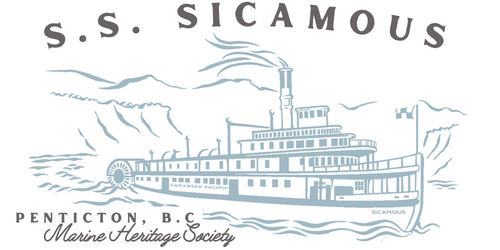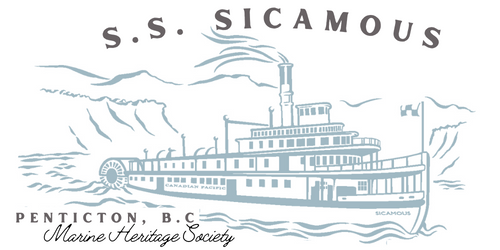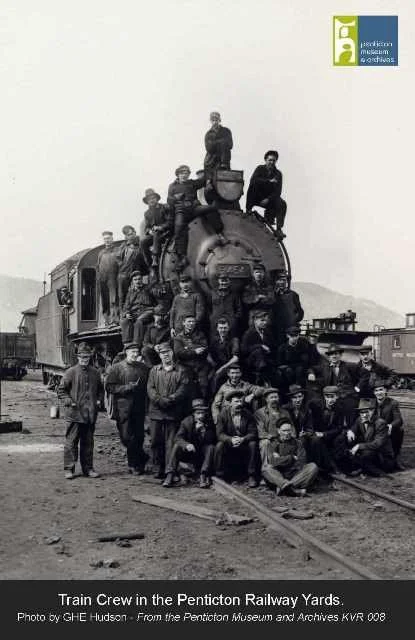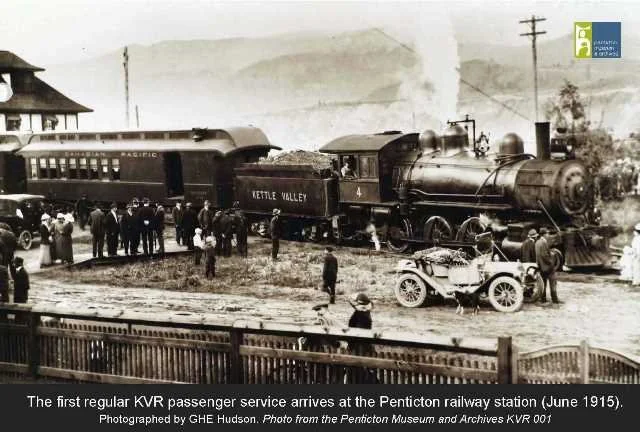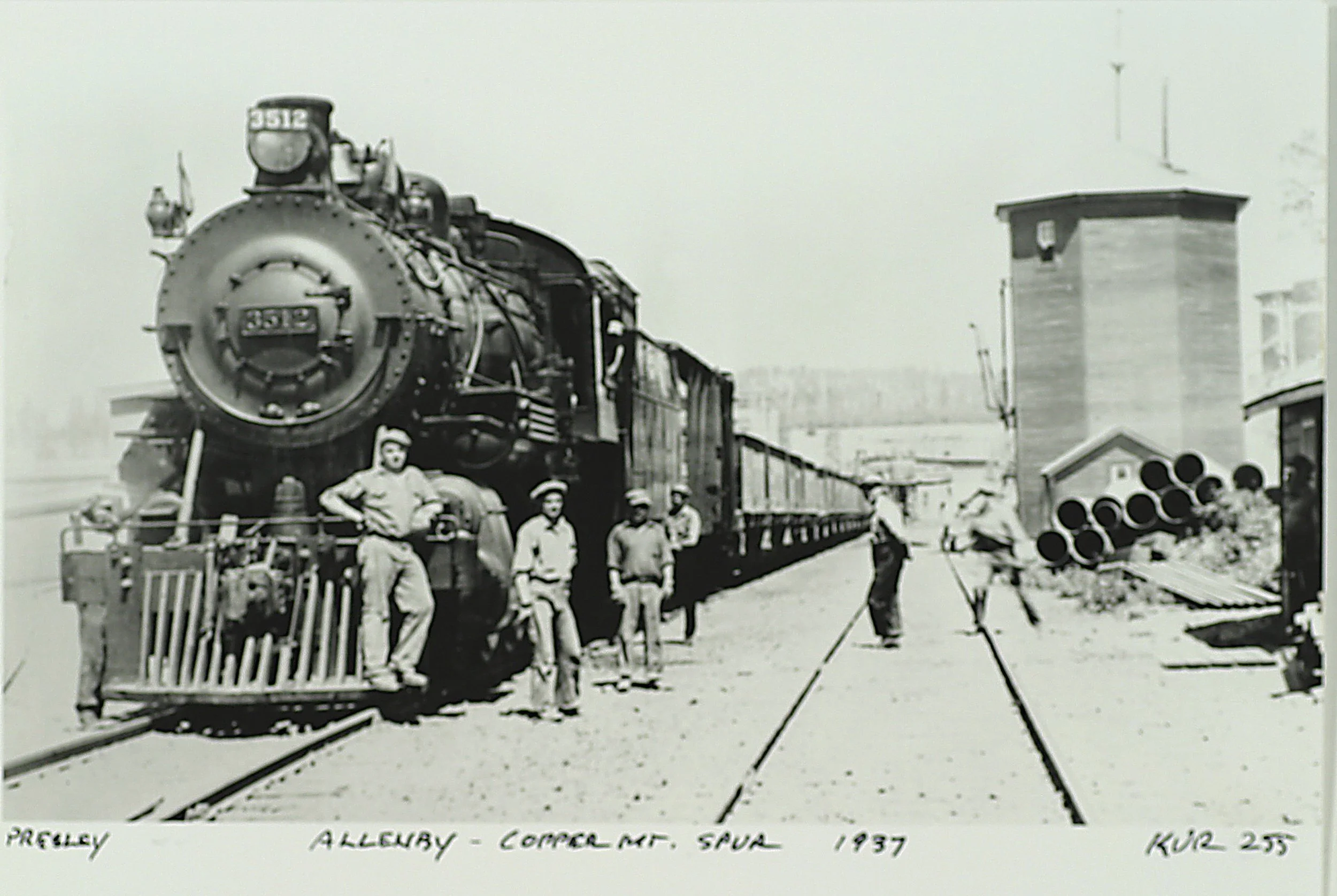
Penticton and the Kettle Valley Railway
Penticton and the Kettle Valley Railway
Did you know? Penticton was once a busy railway town. It was the official headquarters of the Kettle Valley Railway (KVR). Hundreds of railway workers were employed here and the trains played an important part in the day to day lives of Penticton residents.
Railway Operations in Penticton
Penticton was the busiest station on the Kettle Valley Railway. The station was designed to provide a place of business for the railways, and a comfortable place for passengers to wait before boarding the trains and ships.
The Railway Station: The station house was on the Penticton Wharf, at the base of Martin Street. It housed a ticket office and a waiting room. It also provided important services, such as a work area for the telegraph operators and a mail room too.
The Lake & River Boat Service: Passengers could easily board the railway owned stern wheelers from the docks, and reach communities all over the valley within a single day (when travel would have taken weeks over land).
Telegraph Service: Telegraph operators at the Penticton Railway provided an important service. Morse code messages could quickly travel over vast distances. Many homes did not have telephones (or even electricity) and telegraphs provided a fast and reliable way to send and receive information.
The Mail & Express Service: Canadian Pacific Rail has a contract for the mail routes in Canada. Mail would be collected and delivered at each stop along the lake, and across land. Mail would be delivered to the railway station every evening, ready for sorting in the mail room.
The Incola Hotel: This was Penticton's own luxury, railway owned hotel. It was just a few moments from the dock, so passengers could depart the stern wheelers and head with their luggage to book a room.
Incola Hotel
This luxury hotel was owned by the Canadian Pacific Railway. It was built to house passengers arriving on the trains and sternwheelers (such as the SS Sicamous). Look carefully and you can see the railway tracks just running past the hotel. The CPR wharf was part of the Kettle Valley Rail Line, and was just steps from the front door. The hotel opened in 1912, and was demolished in 1981
Train Crew at the Penticton Railway Yards, where trains would be loaded, stored and repaired. Photo from the Penticton Museum and Archives. The trains service required many workers; from engineers to coal passers, baggage handlers, ticket takers, mechanics and more.
Why Penticton?
A key benefit offered by Penticton, was its connection to the lake. The railway companies were able to launch a fleet of lake boats and tugs to compliment the train service.
Tugs like the Naramata were used for transporting supplies and workers to remote and inaccessible areas, and helped to build the KVR.
From Penticton passengers and cargo could travel easily by water, avoiding the barrier presented by the mountains. Connections were available from the Penticton to Vernon, with 14 stops. Once at the north of the lake (at the Okanagan Landing train station) passengers could easily connect with the Trans-Continental railway, that stretched across the whole of Canada.
Produce of the valley was brought on barges and transported by Tug Boats to reach the railway station at the North of the lake, from there produce would travel the rails to the hungry markets of the west coast or the prairies. The railway, together with the steamboats, were vital to the development of the Okanagan valley.
-
The Penticton Railway Station, as seen from the bow of a stern wheeler (possibly the SS Sicamous!) Photo is from the Penticton Museum and Archives.

-
The SS Sicamous at the Okanagan Landing Railway Station. The ship would arrive at the station at 12noon each day, just in time to meet the trains. Photo from the Penticton Museum and Archives.
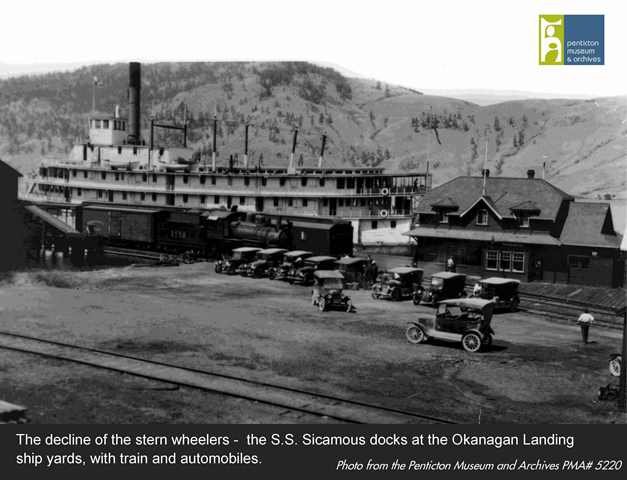
-
The Tug Boat Naramata moves a barge with railway cars. This allowed cargo to be transported quickly over water, without the need to unload cars. The barge service on Okanagan lake lasted much longer than the passenger service. The last commercial run was in 1967 (with Tug #6 - the very last of the Canadian National Railways Fleet)

Building the Kettle Valley Railway to Penticton
The railway line into Penticton was completed in 1915, and the first train arrived on May 30, 1915. The line was not in full operation until after World War 1.
Railway Completion Dates:
Midway to Penticton - Completed Oct 2, 1914
Princeton to Penticton - Completed April 23rd 1915
Hope to Princeton - Completed July 31st 1916
Train Schedules: The KVR train would reach Penticton late in the afternoon, in time to meet a train from Midway. On Tuesday, Thursday and Saturday the train would then head on to Merritt and Midway.
-
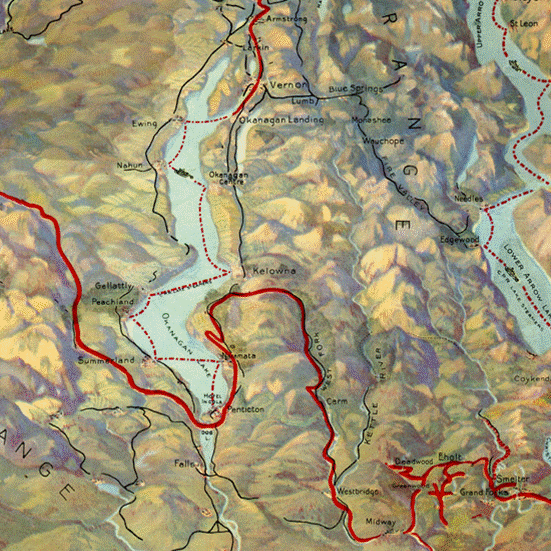
Travelling on the KVR. Detail from a railway pamphlet (circa 1920) showing the train and lake boat routes that a passenger could take to reach Penticton. The thick red lines show the route of the railways, while the dotted lines show the lake boats..
-

Printable map of the full Kettle Valley Railway route, starting in Midway, then on to Hope via Penticton. Map courtesy of Barrie Sanford, McCulloch’s Wonder: The Story of the Kettle Valley Railway.
Stations and Stops on the Main Kettle Valley Line:
Midway, Kettle Valley, Rock Creek, Zamora, Westbridge, Rhone, Taurus, Dellwye, Beaverdell, Carmi, Lois, Lakevale, Cookson, McCullock, Myra, Ruth, Lorna, Chute Lake, Adra, Glenfir, Arawana (Naramata), Penticton, Winslow, West Summerland, Faulder, Crump, Kirton, Thirsk, Osprey Lake, Jellicoe, Erris, Jura, Belfort, Princeton, Parr, Coalmont, Tulameen, Manning, Thalia, Spearing, Brookmere, Brodie, Juliet, Cocuihalla, Romeo, Iago, Portia, Jessica, Lear, Othello, Hope, Odlum.
Stations and Stops on the Branch Lines: Skaha, Kaleden, Okanagan Falls, McIntyre, Oliver, Osoyoos. Allenby, Copper Mountain. Kingsvale, Pine, Glenwalker, Merrit, Nicola, Coutlee, Coyle, Canford, Dot, Agate, Clapperton.
The "End" of the KVR in the Okanagan
In the boom years the KVR hauled fruit, ore, lumber, livestock and passengers too. However in the 1930's fortunes began to change, with a series of bad fruit harvests and heavy winters. The onset of world war II increased business temporarily, as there was an increased need for ore from the mines. The completion of the Hope to Princeton highway was one of the final straws, as people could use their own cars instead of relying on the trains. The tracks were discontinued one by one. The final section to operate was from Spences Bridge to Penticton, with the last train running in 1964.
The Kettle Valley Railway Today
After more than a century since the first tracks were laid, the Kettle Valley Railway routes are alive and well, through not in the way that was first envisioned. The route loops through 500km of beautiful southern BC terrain, and has been converted into a walking, hiking and biking trail. There are several access points for the trail in Penticton. Click below to learn more about finding and touring on the KVR today.
Resources for Learning and Teaching about the KVR
Learning Resource - Kettle Valley Railway - An Okanagan History Vignette (Downloadable PDF)
Learning Resource: A Child's Guide to the Canadian Pacific Railway (Downloadable PDF)
